brunodbo
Naam
Bruno De Bondt
Vakgebied
Web development/design
Topic(s)
Independent media, free & open source software, copyright/left
About Bruno
Gent: Arteveldehogeschool (1999-2002), zine ’Fluxx: een druppel in de tegenstroom’ (interviews Jaap Kruithof, asielzoekers, artikels wantoestanden Turkse gevangenissen, 019 EU-top in Gent (10/2001) */* Utrecht: School voor Journalistiek (2002-04), ’dossier Open Media’ */* Indymedia.be-Print 2002. Persbureau Belga (05-06/2002), De Standaard Online (02-07/2003) */* Geneve ’WSIS/ We Seize (VN-top, Info-society, 12/2003) */* Mede-auteur 'Media-activisme: Don't hate the media, be the media' (EPO, 2004)
Website
Berichten
brunodbo's blog
Vakantie op Guantanamo Bay?
06.05.2008
Nog geen vakantieplannen? Misschien is het vakantie resort 'Taliban Towers' (souvenirshop inbegrepen, zie foto) in Cuba wel iets?
"US authorities are selling holiday accommodation at Guantanamo Bay, Cuba, the prison home of 300 alleged enemy combatants.
The offer is only open to 1.5 million American Service personnel and workers at Gitmo, and the resort (known as Taliban Towers) has a cinema, a golf course, gift shop and access to pristine Cuban beaches complete with resort style watersports. Visitors also have access to Gitmo facilities such as a McDonalds, KFC and even a Wal-Mart."
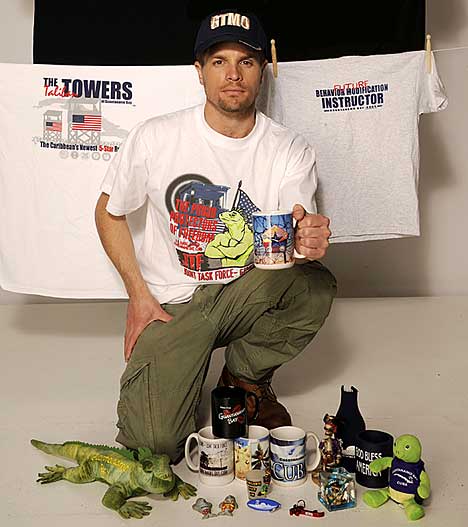
http://www.inquisitr.com/club-gitmo-only-42-night
http://www.dailymail.co.uk/pages/live/articles/news/worldnews.html?in_ar...
| Bijlage | Grootte |
|---|---|
| GitmoGearPop_468x527.jpg | 34.48 KB |
Ubuntu rules :)
01.04.2008
Tijdens de CanSecWest security conferentie (gehouden van 26 tot 28 maart in Vancouver) hield men een wedstrijdje laptops hacken. De MacBook Air van Apple (met daarop OSX) moest er na twee minuten aan geloven, de laptop met Windows Vista hield het vol tot aan het einde van dag 2. Enkel de laptop waarop Ubuntu draaide, bleef overeind:
Of: kom op 27 april naar onze Ubuntu release party :)
Ubuntu + open source handleidingen
16.03.2008
Na de Ubuntu-presentatie bij Green vzw stuurde Mark Van den Borre enkele links door naar handleidingen voor Ubuntu. De handleidingen zijn geschreven voor Ubuntu 7.10 (Gutsy), die in oktober 2007 uitkwam. Er is zowel een versie voor 'studenten' en voor lesgevers. Voorlopig wel enkel in het Engels, maar binnen enkele maanden wellicht ook in het Nederlands en Frans verkrijgbaar.
- https://wiki.ubuntu.com/Training?action=AttachFile&do=get&target=student...
- https://wiki.ubuntu.com/Training?action=AttachFile&do=get&target=instruc...
Wij zijn bij Indymedia.be ook fans van de Ubuntu Guide, te vinden op http://ubuntuguide.org (voor Ubuntu Gutsy, zie http://ubuntuguide.org/wiki/Ubuntu:Gutsy). Veel voorkomende vragen/problemen worden er op een eenvoudig mogelijke manier uitgelegd. Een heel goede manier om echt te léren werken met Ubuntu.
Vul dit lijstje gerust verder aan in de comments.
Drupalcon Boston: What's in it for Indymedia.be?
06.03.2008
I'm currently geeking out in Boston at (yep, you guessed it) this spring's Drupalcon. Drupalcon is the twice yearly event for all things Drupal: developers, themers, site builders, users, fans get together to discuss and work on Drupal. And, of course, to have a lot of fun.
This Drupalcon lasts 4 days, receives 800+ attendees (the event was sold out), had a very cool all-conference party, loads of (very) interesting sessions, and three extraordinary keynotes (Dries' state of the Drupal union, a talk by Google's open source programs manager Chris diBona and one by MySQL's chief architecht Brian Aker. In other words, it's quite a ride.
Even though we still have two days to go (last conference day on Thursday, code & documentation sprint on Friday), I'm going to list some (mostly technical) things that look interesting for us at Indymedia.be. Here goes.
1) (Multi)media handling in Drupal
One of my goals for this Drupalcon was to find out what direction media handling in Drupal is moving into. Since we're building our new site, building content types that are as close to this direction as possible, seems like a huge plus.
After the first session of this Drupalcon (which was all about multimedia in Drupal), I was happy to see that the way we are currently handling images (photos) on Indymedia.be, is the way that Drupal is likely to move forward. The following seems like a probable scenario: the image module will be transformed into what is now imagefield, and will (likely) move into core in Drupal 7. We're currently using imagefield.
Also very interesting: things like automatic resizing and cropping (currently provided by the imagecache module) will also become standard features. Since better image handling is a top user request within the Drupal community, this will get some serious attention for the Drupal 7 release.
For audio & video, things are a lot less clear. There is currently a very good audio module that still fulfills the needs of most users, and for video, well, there are a few options. Things like third party storage of media files are also being looked at (think Amazon S3 and the like).
2) The future of fields
The already wildly popular Content Construction Kit (CCK) module will become even more important for Drupal. With CCK, you're able to define your content types (eg. photo report, audio, video) by adding fields through the UI yourself (as opposed to using modules that define complete content types). Good thing: we switched from the outdated Flexinode module to CCK last summer.
During their presentation on Tuesday morning, some of the main CCK developers outlined their vision for the module. A few weeks before Drupalcon, they got together in Chicago to discuss the future data architecture of Drupal. Tuesday's session was meant to present the results of that meeting and to ask for feedback from the community (or: a good example of how open source works).
On top of CCK being extremely flexible, it also allows for other interesting things, such as mixing local and external data. As in easily integrating a photo from Flickr in your article. Although these are still future plans for CCK, they seem to align nicely with Dries' vision for Drupal, which he presented in his keynote on Monday morning. Interesting quote from Barry Jaspen, CCK developer (now employed at Acquia): "A site that only works with local data is like a computer that is disconnected from the internet. It is useless."
3) Performance
Some key people involved with Drupal performance and scalability presented some tips and techniques for running large Drupal sites, and running them fast. Optimisation of the server (a traditional LAMP stack in our case) was an obvious first requirment for running a Drupal installation decently. Also mentioned: memcache (this was talked about in a few presentations, so definitely worth checking out) and PHP opcode cache. Generally (MySQL's Brian Aker also mentioned this) the current way of running things seems to be to add caching layers between the application and the database (such as memcache) instead of making direct calls to the database. David Strauss pointed out some high level MySQL tuning that I'll have to read through again (honestly, it made my head spin yesterday).
4) Panels 2 / Nodequeue
Two modules that we'll definitely be using (pretty intensively) on our new site, are Panels and Nodequeue. They are both related to the lay-out and presentation of content, and will allow us to present the headline stories the way you can see in these mock ups, as well as the lay-out of those pages. Panels lets you define custom lay-outs from within Drupal, and manipulate these as you wish. Once you have everything set up, you can then export them to a module, and keep them in the file system on your site (instead of storing them in the database) for increased performance. Both modules (Panels & Nodequeue) have undergone serious work lately, so we're looking forward to using them.
5) Context
A problem in Drupal, and something we really really need for our new site, is context. Context is the notion that your site is aware of where you are in your site. Say, you're reading an article in the 'media' section, then it is the context that (should) decide(s) what to display around that piece of content. Currently, this doesn't work very well in Drupal and there are several ways in which people try to solve this problem. Young Hahn and Jeff Miccolis from Development Seed presented their take on the issue. We'll definitely be checking out their solution, as well as the way Panels handles this.
Drupal user power
04.03.2008
Today, first day of DrupalCon, the twice yearly meeting of Drupal'ers, this time in Boston. Some very interesting talks were planned today, ranging from multimedia to OpenID implementations in Drupal. Personal high point of the day was the keynote of Dries (Drupal project lead). You read more about that here. The following slide expresses really well why Indymedia.be is still thrilled to use Drupal. Clearly, one of the main goals of Drupal remains to empower people to publish content on the web, without the help of webmasters, developers, designers or publishers. Power to the user, that is.
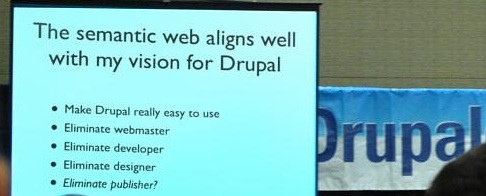
(Photo by Stefaan Lippens)
| Bijlage | Grootte |
|---|---|
| drupal_powertousers.jpg | 71.7 KB |
Ubuntu bij Indymedia.be
25.02.2008
Enkele weken geleden kwam er bij Indymedia.be een vraag binnen van asbl Green vzw om een presentatie te geven over Ubuntu. Samen met Mark Van den Borre ging ik vanmiddag dan ook tekst en uitleg geven over de Linux-distro 'for human beings'. Mark had het over Ubuntu in het algemeen (wat is het, hoe werkt het systeem, hoe zit de community in elkaar, ...), ik lichtte het gebruik van Ubuntu bij Indymedia.be toe.
Voor wie meer wil weten hoe we bij Indymedia.be gebruik maken van Ubuntu:
1) de slides
2) het 'spiekbriefje' (zie hieronder) - ooit komt er nog wel eens een artikel van ;-)
###
Ubuntu talk Green vzw
- Indymedia.be & vrije software
- Sinds het begin ...
- 1999: WTO Seattle, Active, ...
- Nadien CMS'en verder ontwikkeld als vrije software: samenwerking (vergelijkbaar met hoe we als mediamakers samenwerken) / kostprijs
- Vandaag werken we zoveel mogelijk met vrije / open source software:
- Firefox, Open Office, GIMP, Drupal, servers, en natuurlijk Ubuntu
- enkel voor video nog 'problemen'
- geen noemenswaardige problemen (behalve een printer of een scanner die niet meteen werkt)
- betrokkenheid in community: workshops GIMP, Drupal-avond, Ubuntu install parties, ... 'iets terugdoen'
- Vrije informatie met vrije technologie
- Onafhankelijkheid (hoewel die relatief is ...)
- Voelen ons schatplichtig aan de vrije software-beweging, veel overeenkomsten (openheid, participatie, do it yourself, ...)
- Vrije software-beweging: zo goed mogelijke software maken / Indymedia: zo goed mogelijk media maken => geen winst-motivatie (hoewel je wel geld kan verdienen met vrije software)
- Indymedia.be & Ubuntu:
- Sinds de eerste release in 2004
- Waarom:
- Gebruiksvriendelijkheid
- Focus op eindgebruikers
- Zekerheid van regelmatige nieuwe releases, zodat je steeds met up-to-date technologie werkt (recente tech, maar wel getest etc)
- Elke release wordt beter op vlak van multimedia-ondersteuning
- Vrijwilligers, medewerkers, stagairs
- Zelden problemen bij omschakeling Windows > Ubuntu
- Helpdesk (geen IT-afdeling) ...
- Sinds het begin ...
Lezing Nico Carpentier tijdens Burgermediadag
18.02.2008
Tijdens de Burgermediadag (op 17.02.2008 bij Indymedia.be) gaf Nico Carpentier tekst en uitleg bij de bijdrage die hij schreef voor 'Burgermedia: opmars, ervaringen, bedenkingen'. Nico's lezing was meteen ook de lancering van dat boek, een uitgave van Indymedia.be.
Zeer interessante lezing, waarin gewezen werd op de valkuilen van Web 2.0 (door onder meer de vaak beperkte invulling van het begrip 'participatie' in heel de Web 2.0-hype) en op het feit dat heel het burgermedia-gegeven allesbehalve nieuw is. De slides kan je hier downloaden.
Je kan alles nalezen in het stuk dat Nico Carpentier schreef voor 'Burgermedia', hier te downloaden.
| Bijlage | Grootte |
|---|---|
| keynote_carpentier_20080217.pdf | 1.83 MB |
Irak / Valse verklaringen leidden tot oorlog
24.01.2008
Afgelopen dinsdag (22/01/2008) verscheen een studie die aantoont dat G.W Bush en VS-topambtenaren honderden valse verklaringen aflegden tijdens de twee jaren die volgden op de terroristische aanslagen op 11 september 2001. Het Center for Public Integrity werkte voor de studie samen met het Fund for Independence in Journalism. De 935 valse verklaringen die de studie aanhaalt, 'were part of an orchestrated campaign that effectively galvanized public opinion and, in the process, led the nation to war under decidedly false pretenses.' De studie baseert zich op toespraken, briefings, interviews, boeken, artikels en regeringsverslagen.
- Aankondiging op European Journalism Centre
- Studie op de Center for Public Integrity-website
Red deredactie.be
09.01.2008

Afgelopen maandag (07/01/2008) lanceerde de VRT-nieuwsdienst haar nieuwe website. Een reactie op enkele inhoudelijke veranderingen kon je hier al lezen. Zoals dat gaat met websites (en media in het algemeen) is er ook een vormaspect: lay-out, structuur, design. Over de vorm van de nieuwe VRT-site is er alvast heel wat te doen in webland. Vooral de onduidelijke (of het gebrek aan?) structuur en de lastige navigatie moeten het ontgelden. Een goed geschreven (en technisch onderbouwde) analyse vind je bij Niels Wouters.
Sommige designers/bloggers vinden de nieuwe site zo (spuug)lelijk, dat ze besloten om zelf een alternatief design te ontwikkelen. Op http://de-red-actie.be/ kan je het project opvolgen (een eerste voorstel vind je hier).
Bij Indymedia.be storen we ons (naast eerder genoemde zaken) vooral aan de videootjes die automatisch beginnen te spelen als de website laadt. Bij Canvas doen ze dat tegenwoordig ook, zelfs met geluid erbij. De Flash-toepassingen werken ook niet allemaal bij ons. Zo speelt de fullscreen video helemaal niet fullscreen, maar enkel in het kleine vierkantje van de 'fullscreen'-link (op Ubuntu Gutsy, met de Adobe Flash Player).
Wij beginnen deze dagen met de ontwikkeling van onze nieuwe site. Enkele schetsen vind je hier. We zetten zo snel mogelijk een beta-versie op (updates volgen op deze blog).
| Bijlage | Grootte |
|---|---|
| deredactie-excuus3.jpg | 15.18 KB |
Ubuntu-be Kick Off 2008
08.01.2008
Afgelopen zondag (06 januari) kwamen de mensen van Ubuntu-be samen bij Indymedia.be voor hun startvergadering 2008. Tijdens enkele sessies bespraken de Ubunteros de organisatie en uitbouw van de Belgische Ubuntu-community, promotie, perscontacten, ... Hieronder enkele foto's.
Er staan in 2008 ook weer enkele release & install parties/events op het programma bij Indymedia.be (meer hierover later), in Hasselt Herk-de-Stad en waarschijnlijk ook op andere plaatsen in het land. De volgende release van Ubuntu is gepland voor april 2008.
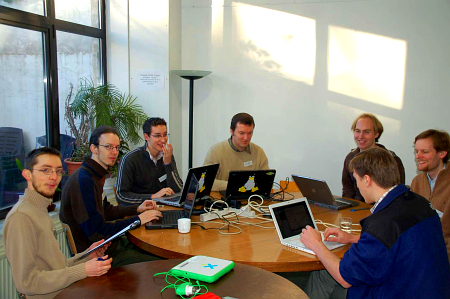
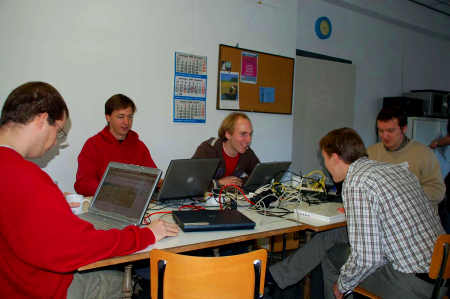
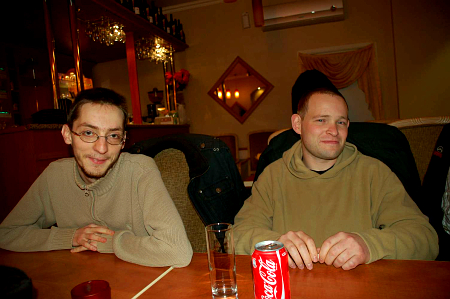
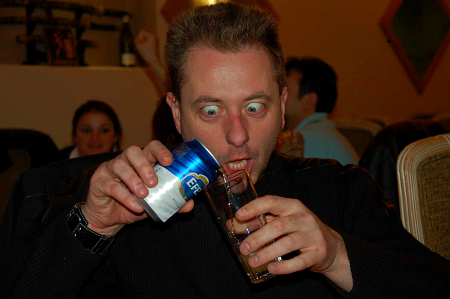
| Bijlage | Grootte |
|---|---|
| ubuntu_kickoff2008_01.jpg | 174.19 KB |
| ubuntu_kickoff2008_02.jpg | 151.55 KB |
| ubuntu_kickoff2008_03.jpg | 172.92 KB |
| ubuntu_kickoff2008_04.jpg | 135.89 KB |
Eboman Sample madnesS
28.10.2007
In 2004 zagen we Eboman aan het werk op het Media Art Festival in Leeuwarden, waar we waren uitgenodigd om het Media-Activisme-handboek voor te stellen. Eboman heeft nu een website, waarop hij verschillende samples van zichzelf samenbrengt: http://www.eboman.info/. Een aanrader.
450 mensen op DrupalCon in Barcelona
24.09.2007
Van 19 tot 22 september was Barcelona het decor van de halfjaarlijkse DrupalCon(ferentie). Vier dagen lang kon je er presentaties & workshops volgen of deelnemen aan een van de hacking-sessies om problemen in Drupal op te lossen of de functionaliteit ervan te verbeteren. Kortom: Barcelona was even "het centrum van het Drupal-universum" (dixit Bert Boerland tijdens de openingssessie). Ik zet hieronder enkele hoogtepunten op een rijtje, zowel persoonlijk als voor Indymedia.be:
- Enkele weken geleden voerden we enkele aanpassingen uit aan de Indymedia.be-website. Tijdens heel wat DrupalCon-sessies werd bevestigd dat die veranderingen betekenen dat we nog een heel eind verder kunnen met Drupal. De modules die we op deze website gebruiken, worden immers heel erg gesteund in de Drupal-community - omwille van hun kwaliteit en omdat er intussen heel wat (grote) website van afhangen. Met andere woorden: we zitten op de goeie weg.
- Heel wat opgestoken van andere media-websites die op Drupal draaien: NowPublic.com, New York Observer, Rue89, ... Daarnaast ook veel ideeën opgedaan om onze Drupal-implementatie te verbeteren en uit te breiden. Werk aan de winkel dus.
- Het gaat goed met Drupal :) De zaken die ik gezien heb, bevestigen voor mij dat Drupal een kwalitatief zeer hoogstaand open source project is, zowel wat de software als de community betreft (zie lager). Tegelijk blijven er heel wat zaken op te lossen: marketing, de vindbaarheid van goeie documentatie voor beginners - daarmee aansluitend, de 'vriendelijkheid' van Drupal.org voor beginners, verbeteringen aan de user interface, ... Er is een voelbare, sterke drive om Drupal nog veel beter te maken.
- Voorstelling van Panels 2: een fantastische module die het creëeren van flexibele & complexe lay-outs vergemakkelijkt en dit ook mogelijk maakt voor mensen die niet programmeren.
- De Barcelona-trip was ook voor het Krimson-team een topper. Veel Drupal'ers ontmoet en gesproken, goeie contacten gelegd, en samen een heel coole reis gehad.
- DrupalCon = Drupal community in live action. Bugs fixen, nadenken over functionaliteit, werken aan verbeteringen in Drupal, samen pinten pakken, geekin' out, ... Er werden tegelijk heel wat mogelijkheden aangereikt om actief te worden in de Drupal community, ideaal voor mensen die willen bijdragen aan het project maar tot nu toe niet goed wisten hoe, wat, ...
Presentaties en video's zijn te vinden op http://barcelona2007.drupalcon.org/ . Nogmaals een dikke proficiat en dankjewel aan het DrupalCon2007-team voor de organisatie van de conferentie.
Indymedia.be upgrades to Drupal 5 and converts from flexinode to cck
21.09.2007
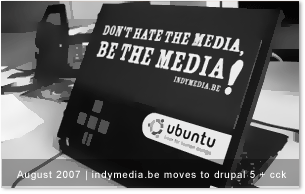
If you're currently using Flexinode and are worried to be terribly stuck with your Drupal website, fear no more. For now (well, it's been there since January 2007) there is the great Flexiconvert module by starbow. Over at www.indymedia.be, we used Flexinode for two years and ended up with 8000+ Flexi-nodes. Once Drupal 5 came out, I started to dream about upgrading, and moving to CCK at the same time. Other projects kept me from testing it thoroughly for a long time, but a few weeks ago I got to it: I'm very happy to be able to say that we're now running Drupal 5 and replaced Flexinode with CCK.
Even though the process is well described (upgrade to Drupal 5 here; how to use the Flexiconvert module here), I thought it might be useful to describe step-by-step how I did it. If you have further questions about the procedure we followed, or would have done things differently, please comment. All feedback is welcomed.
For your information: I converted my Flexi-nodes while still on Drupal 4.7, and upgraded to Drupal 5 afterwards. I haven't read any reports of people doing the Flexinode-to-CCK-conversion in Drupal 5, but since there is a 5.x-version of Flexiconvert, I imagine the conversion should work on Drupal 5 as well.
Convert you Flexinode nodes to CCK nodes
Before you begin: go and make a backup of your database (and, why not, your Drupal installation files).
1) Change your Flexinode content types' names into something nice
Since you'll be matching your Flexinode content types with new CCK content types, it's helpful that you have good names for them: it will make management of your content types easier over time. You can always change the names of your CCK content types afterwards, but why not take care of it right away. Tip: note down these names, as you'll need these after you've disabled the Flexinode module(s).
2) Make all Flexinode field labels unique
All Flexinode field labels should be unique. After a few tries, I opted for very simple labels (eg. 'artext' instead of 'Paste your article's text here' for a node body). Make sure the labels are meaningful to you though: you'll need these labels for your new CCK content types' fields as well (see below), so it might be helpful if they still have a meaning to you in a few months.
3) Switch off Flexinode
Navigate to the module management page in your Drupal admin area, and disable the Flexinode module (and, if you have it installed, the Flexinode admin module).
4) Switch on Flexiconvert
If you haven't already, download the Flexiconvert module and put it in your contrib module directory. Navigate to the module management page in your Drupal admin area, and enable the Flexiconvert module.
5) Create your new CCK content types
If you haven't alreay, download the Content Construction Kit and put it in your contrib module directory. Enable it on the module management page.
Navigate to the content types' page and create your new CCK content types. Take care of the following:
- use your old Flexinode content types' names for your new CCK types
- use your old Flexinode content types' field labels for your new CCK types fields' names
Important: do not associate taxonomy vocabularies with your new CCK content types until after the conversion.
6) Convert your Flexi-nodes to CCK nodes
The big moment: navigate to the Flexiconvert page in your Drupal admin area. Select the appropriate Flexinode type to read from and the appropriate CCK type to insert in. Start the conversion by clicking on the button underneath the select boxes. After a while, you should see a confirmation message saying that your nodes have been converted. Yay!
7) Delete flexinode tables in your database
Once you converted your Flexi-nodes to CCK nodes, and you verified that the new CCK nodes work, you can safely delete your flexinode tables from your database. This isn't a must though - if you'd rather keep them for some reason, feel free to do so. I just figure your database is cleaner without them (especially if you have had a lot of Flexi-nodes as we did on our website).
8) Associate taxonomy vocabulary/ies with your new CCK content types
If you had taxonomy vocabularies associated with your old Flexinode types, you can link these vocabularies with your new CCK types now. Navigate to your Categories management page in your Drupal admin area, go to the appropriate vocabulary page, and link your new content types to it (somewhere half way down the page).
Tips/things to watch our for:
- PHP memory
When I tried out the conversion (step 6) for the first time, I ran into PHP memory errors (white screens et al). Meaning: PHP was running out of memory and needed more of it. I went into my php.ini file (located in /etc/php4/apache2/php.ini on our Debian server), and increased the memory setting to something higher (100MB) than it was (32MB). If you need to do this, make sure to change it back to its original setting after the conversion is completed.
- No confirmation message
When testing the conversion, there where a few times I was waiting and waiting for the Flexiconvert confirmation message, and it just wouldn't come. This is not neccesarily a bad thing: if I waited long enough and clicked the Flexiconvert link (in the admin menu), the confirmation message appeared, and all the nodes were converted correctly. If I didn't wait long enough though, I could go back and start all over again. So, make sure you wait long enough before clicking that link, depending of how many nodes you have of a certain type ...
- Variable table
There will be some Flexinode related variables in your Drupal variable database table. You can delete these (and only there) using PHPMyAdmin or a similar tool.
- Make backups
To save you (a lot of) time, it is advisable to make backups of your database once in a while when working on this. If something goes wrong during the conversion process (see the two items above), it's nice if you can go one or two steps, instead of having to start all over again.
- Make backup
That said, make a backup before you begin this conversion process. Better yet, do the whole thing on a test server if you have one available.
2) Upgrade to Drupal 5
After the Flexinode -> CCK conversion, there was still the Drupal upgrade itself that needed be done. Since this was pretty straight forward, and since it's very well documented here, I won't elaborate on that in this post. A few things though:
- I had a (rather serious) problem using token.module (required for the pathauto.module that we use on our site) and link.module (providing url fields for CCK content types). After having upgraded to Drupal 5, nodes that used the link.module (or taxonomy term pages showing such nodes) trigerred an Apache segfault. The fix was easy: un-check the box that says 'Allow tokens' in the link field's settings. It was this post that saved my life (thanks Joeri for pointing me to it!).
- As is mentioned in other upgrade documentation: it is a good idea to clear your cache tables after upgrading.
- Every time I tested this upgrade, I had to create the views.module's cache database table manually. I simply did a clean install of Drupal 5 and the views.module on my local machine, dumped the views.module's cache table's structure, and insterted it in our live database.
So, I believe that's about it. I hope this post is helpful so some people. Again, feel free to post questions, suggestions, remarks etc.
Good luck & have fun with Drupal 5!
| Bijlage | Grootte |
|---|---|
| item-indymedia-august-2007_0.png | 21.49 KB |


